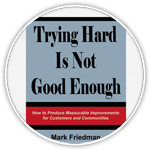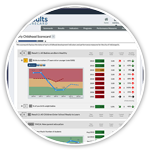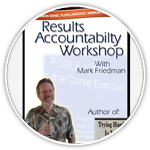A. Introduction
Here are links to FPSI publications, including papers published by the Finance Project, UCLA and the Center for the Study of Social Policy. Most of this work has been sponsored by various foundations and non-profit organizations, including the Annie E. Casey Foundation, The Carnegie Corporation, The Foundation Consortium, The Finance Project and The Center for the Study of Social Policy (CSSP). Government and non-profit organizations may copy, distribute and use any of this material, providing it is done with attribution and in the interest of improving the well-being of children, families and communities. All documents are by Mark Friedman unless otherwise noted. FPSI is the publishing organization unless otherwise noted.
B. Videos
- RBA 101 2.5 Hour Workshop Video: The full 2.5 hour presentation with Q&A and other features – FREE (formerly $80 DVD)
- RBA 101 One Hour Video from the 2012 Local Immigration Partnerships (LIPs) Conference in Ontario Canada. Not as complete as the RLG video bu all the basic ideas in an hour. The only problem with the video is that it does not do a good job of showing the Powerpoint slides. So it would help if you printed off a copy of the RBA 101 handout material which contains most of the slides that go with the video. https://www.youtube.com/watch?v=OsKb9YRxgt4
- CNBC Africa interview with Mark Friedman: This 12 minute inteview provides a surprisingly compact introduction to RBA. The interview took place as part of the RBA Africa Summit in Johannesburg Oct 1 – 10, 2014
- Dorset OBA Webinar 13 July 2016. See posting for more details.
C. Results Based Accountability™, Outcomes Based Accountability™ (Main characters)
- Trying Hard Is Not Good Enough 10th Anniversary Edition: How to Produce Measurable Improvements in Customers and Communities 2015 Edition (FPSI) (from amazon.com) (from RLG) WHAT’S NEW? – Significant Changes in the 10th Anniversary Edition 2015
- Trying Hard Is Not Good Enough 2009 Edition (FPSI) (from amazon.com) (from RLG)
- Turning Curves: An Accountability Companion Reader, 2015
- The RBA/OBA Implementation Guide, www.raguide.org
- RBA 101 Workshop Handout Material 2.0
- RBA 101 Workshop Powerpoint: Now you can present Results Accountability concepts using Powerpoint. Adapt the presentation to your own needs. Or use it as a tutorial, clicking through the slides and reading the notes.
- RBA The RBA/OBA Implementaion Self Assessment Questionnaire (with scoring instructions): Use this tool to judge how well you are doing on each element of RBA/OBA, as a starting point to discuss how to get better. The questionnaire also serves as an implementation checklist.
- RBA Turn the Curve Exercises from Trying Hard Is Not Good Enough Appendix E: These are essential exercises for getting from talk to action at the population and performance levels. Each exercise can be completed in about an hour.
- RBA Performance measurement identification from Trying Hard Is Not Good Enough Appendix G : This is the essential exercise for the identification of performance measures.
- Selected RBA 101 Powerpoint Slide Sets: Download slide sets used in FPSI RBA 101 workshops.
D. Results Based Accountability™, Outcomes Based Accountability™ (Supporting Cast)
- RBA Facebook Selected Essays for Discussion v5 This is a collection of some of the more important postings to the RBA/OBA Facebook Group.
- Collective Impact Using RBA (2 page summary): Collective Impact and RBA are a perfect fit. The idea of working together to produce community “impact” is at the heart of both bodies of work. And RBA compliments Collective Impact in other ways. Collective Impact literature sets out conditions for the success of community change efforts, and RBA provides specific methods to help partners meet those conditions. More and more places are describing their work in terms of implementing Collective Impact using RBA. French translation: Impact Collectif et R.A.R.
- Excerpt from RBA Companion Reader THE LEEDS STORY by Nigel Richardson and Adam Hewitt (2015)
- Excerpt from RBA Companion Reader The Cardiff and Vale Experience by Ruth Jordan and Vicki Myson (2015)
- Next Generation Contracting: A Contract Reform Agenda for Funders and Nonprofits (updated v5) This paper shows how RBA can be applied to the methods by which government agencies and private philanthropies write agreements with those to whom they give money. It complements the other material on this site about Results Based Grantmaking. November 2013
- Results Based Grant Making: An Approach to Decision Making for Foundations and Other Funders Most funders preach accountability but they don’t practice it well. This paper explores how funders might behave if they took their own rhetoric seriously – both in terms of grant making and also internal management practice. (FPSI, 2000)
- Results Accountability for Prop 10 Commissions: A Planning Guide for Improving the Well-Being of Young Children and Their Families (UCLA Center for Healthier Children Families and Communities) Edited and abridged for presentation at the Conference on Promoting the Wellbeing and Monitoring Outcomes for Vulnerable Children Worcester College, Oxford, UK September, 2002: Original paper prepared for The Center for Healthier Children, Families and Communities University of California, Los Angeles March, 2000
- A Guide to Developing and Using Performance Measures (The Finance Project)
- 11 Things a Legislature could consider doing to promote Results Accountability
- Results Accountability Teaching and Coaching Construction Kit.: This 35 page workbook can be used to fashion an individual approach to teaching the concepts of Results Accountability. It also provides guidance on conducting key group exercises.
- RBA Brochure: All the basic ideas of Results-Based Accountability™ on two just pages.
- RBA Journey Analogy (Powerpoint)
- FPSI comments on the UK National Indicators for Local Authorities and Local Authority Partnerships: submitted to the Local Government Quality and Performance Division, London ( 2007).
- Fire Department Performance Measures FPSI Draft Analysis
- The Sorting Exercise and Card Decks: This is an advanced exercise that allows participants to place turn the curve story components into the correct RBA categories.
- Trying Hard Is Not Good Enough – The story behind the sales curve at 50,000.
- OBA response to The View June 2016 special edition, 28 July 2016
- The Architecture of Accountability British Mansion Edition March 2018
- The Architecture of Accountability Schematic Mansion Edition March 2018
- Tool for Choosing a Common Language – Excerpt from Turning Curves
E. Results Based Budgeting
- From Outcomes to Budgets This is the original 1995 paper on Outcome Based (or Results Based) Budgeting. Many of the foundational concepts in Results-Based Accountability™ are presented here for the first time.
- A Strategy Map for Results-Based Budgeting (1996, The Finance Project)
- Reforming Finance-Financing Reform: What Works Policy Brief – published by The Foundation Consortium This is a summary of a wide range of results accountability and financing topics, including: Why bother with financing reform?, How to create finance systems driven by results, Results based budgeting across systems, Performance budgeting within service systems,
- Cutting Budgets with RBA (Powerpoint presentation) If adding money to the budget involves doing the most good, then cutting the budget requires doing the least harm.
- Least Harm Cutback Exercises Exercise instructions for generating cutback ideas at the population and performance levels.
F. Financing Reform of Family and Children’s Services
- The Cosmology of Financing: An Approach to the Systematic Consideration of Financing Options (CSSP)
- “Why Should I Care?” Reasons to Invest in the Well-being of Children and Families: County City and Community Partner Perspectives
- What you need to know about Privatization: When government-delivered services are contracted out to for-profit and/or nonprofit providers, it is called “privatization.” While this method has been part of the government landscape for many years, elected officials and government managers often don’t know the basics of when privatization is appropriate and how to make it work.
- A Financing Self Assessment Questionnaire Questions to Answer about Financing an Agenda
- The Pros and Mostly Cons of Contingency Fee Contracting for Revenue Maximization This paper discusses when contingency fee contracting makes sense and, candidly, presents the general case against use of contingency fee contracts for revenue maximization efforts.
- A Recreation Entitlement We need to invest in recreation for our young people. Here’s a practical proposal for foundation or other funding to create a recreation entitlement for all children age 7 to 17 in a city or neighborhood, for about $380 per year per child.
- The Most Results for the Least Money: some non-conventional grant-making ideas, (including A Recreation Entitlement)
- Managing to Make Government Make a Profit
- Revisiting Supervised Therapy: Modeling the epidemiology and costs of directly observed therapy in Baltimore (1998, C. P. Chaulk, M. Friedman, R. Dunning) This is a good example of (properly done) cost benefit analysis.
- Capturing Cash for Kids: A Workbook for Reinvesting in Community Based Prevention Approaches for Children and Families (with Marty Giffin, Abram Rosenblatt and Nancy Mills, The Comprehensive Integrated Services Reinvestment Project)
- A Working Paper on Reinvestment in the Well-Being of Children and Families: Opportunities for Prevention Funding We Cannot Afford to Squander
- A Few Ideas about how to Finance Family Support Centers
- Measuring the Commitment to Reinvestment: Tracking State and Local Use of New Federal Funds (CSSP)
G. Negotiating New State/Local Fiscal Relationships
- Trading Outcome Accountability for Fund Flexibility (CSSP)
- Organizing by Outcomes: A Different Organization Chart for State/Local Partnerships to Improve Outcomes for Children and Families
- We’re Here to Partner with you as long and you want to work on our agenda
- An Exercise in Negotiating new State/Local Fiscal Relationships (with the University of Maryland, School of Public Affairs)
- Bicameral Governance: A Necessary Precondition of State/Local Core Dollar Devolution
H. Things not so easily categorized
- ChildTime this chart shows how adult time periods seem MUCH longer to children. It should be on the wall of every
court room dealing with the well-being of children. - The Most Results for the Least Money: some non-conventional grant-making ideas, (including A Recreation Entitlement)
- The Matter of Evidence: A Short Treatise on the Rules of Evidence in Budget Court (for the California Reinvestment Project)
- The End of the Melting Pot: The Challenge to Create a Healthy Multi-cultural Society
- Some Recommendations for Action on Drunk Driving for consideration by the New Mexico Governor’s DWI Strike Force. November, 2006
- Collaboration Game an innovative and fun way for groups to learn to work together.
- A Complete Course in Supervision (in under 5 minutes)
- Keevers article from NSW misrepresents RBA – OBA
- UN Development Goals Draft Comments
- Average Length of Stay: A Grand Unification of Public Welfare Planning
- Foster Care and Adoption Simplification Act: An Alternative to the Proposed Child Protection Block Grant (CSSP)
- A Call for Open Architecture in Social Innovation



